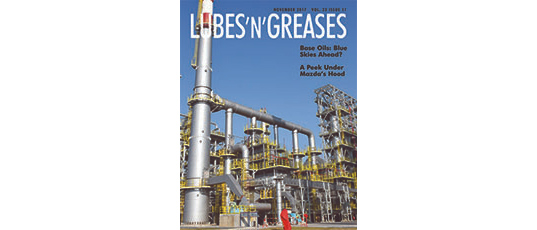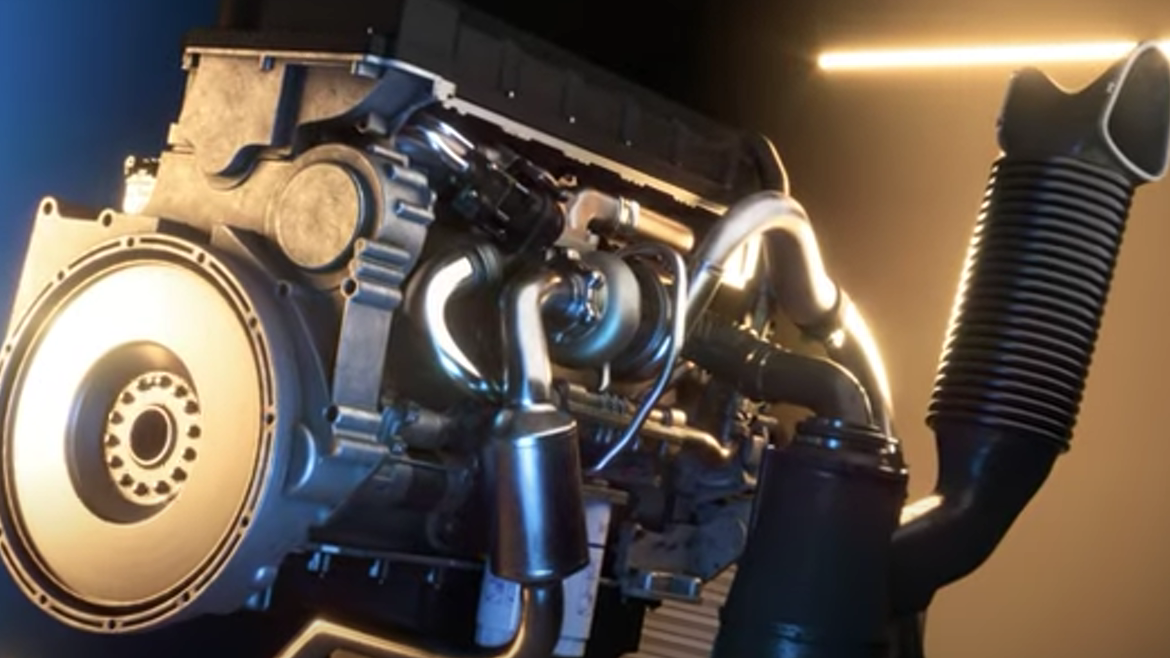Courtesy of Lubes N Greases
Heavy-duty engine oils, which protect diesel engines, are facing a barrage of changes. Formulators must meet ever stricter fuel economy regulations as well as restrictions on greenhouse gas emissions. They must ensure their lubricants are compatible with changes to fuels, including increasingly common biodiesel, while protecting modern engines with tighter tolerances and higher operating temperatures.
Formulation Trends
Up to a quarter of an automotive engine formula is made up of an additive package, viscosity index improvers and other inhibitors, according to Chevron. The other three-quarters is base oil. As environmental regulations and fuel economy mandates become stricter, formulators are increasingly turning to lighter base oils for their heavy-duty products.
Market research firm Kline & Co. predicts that, between 2015 and 2025, the share of HDEOs formulated with API Group I base oil will drop by half, while Group II and Group II+ base oils will more than double to become about 70 percent of what's used. Group Ill oils will increase from 4 percent to 6 percent.
Original equipment manufacturers have been designing engines to use oils that are additized with less sulfated ash, phosphorus and sulfur (SAPS) to protect their emissions handling systems, said Mike Brown of SK Lubricants. This has led to more recommendations to use higher performing, lighter viscosity HDEOs in their engines.
Lighter Viscosity
Traditionally, monograde oils have accounted for more than 80 percent of global heavy-duty demand, along side SAE 15W-40 and heavier multigrades. In North America, 1 5W-40 dominated the market last year at 74 percent, followed by 10W-30 at 15 percent, according to lnfineum.
But increasing acceptance of lower viscosity grades is evident in the 5 per cent gain for SAE 10W-30 over 2015's numbers. lnfineum predicts this trend will push 15W-40 down to about 40 percent by 2027, with thinner oils filling the gap.
Lowering oil viscosity directly affects the bottom line for fleet operators. Lower viscosity products can improve fuel economy, which is a critical cost center for any fleet. For a company like Ryder, which owns a 200,000-vehicle fleet that averages 250,000 miles per year per unit, even a modest improvement in fuel economy has a dramatic impact on profitability.
Many OEMs are now factory-filling their trucks using fuel- saving engine oils. European companies like Volvo, Scania, MAN, Renault and Mercedes Benz (Daimler) favor both fully synthetic SAE 5W-30 and semi-synthetic 10W-30 viscosity oils, while major U.S. companies such as Daimler Trucks North America (Freightliner), Cummins, Paccar, Mack and Navistar prefer 10W-30 for initial fill.
While off-highway operators and equipment builders will be more reluctant to switch from SAE 15W-40, Brown believes that on-highway fleets of trucks and light diesel pickups will see more use of 10W-30 oils, including semi-synthetics, by 2024.
Quality Assurance
The American Petroleum Institute certifies the quality of heavy-duty oils that meet standards laid out in its voluntary Engine Oil Licensing and Classification System, also known as API 1509.
API's latest Service Category for heavy-duty engine oils, API CK-4/FA-4, hit the market on Dec. 1, 2016 - nearly one year ago. Following the over-ten-year-old CJ-4 category, these oils are meant to provide "improved shear stability, oxidation resistance and aeration control, as well as protection against catalyst poisoning, particulate filter blocking, engine wear, piston deposits, degradation of low- and high-temperature properties and soot related viscosity increase," explains API.
API CK-4/FA-4 is the first "split" category for heavy-duty oils. As with past categories, CK-4 is backwards compatible and can be used in older engines. FA-4 provides greater fuel economy and reduced emissions, but is intended only for the newest diesel engines.
With development spanning five years and costing over $400 million, API CK-4/FA-4 has the distinction of being the most expensive heavy-duty engine oil category. Its predecessor, CJ-4, was released in 2006 and cost less than half of what CK-4/FA-4 did to develop.
The new oils have gained good acceptance in the market, with more than 600 API CK-4 and more than 60 FA-4 licensed products available. All of the major heavy-duty OEMs now recommend CK-4 oils.
An important change facilitated by API CK-4/FA-4 products is the significant extension of oil drain intervals. On average, manufacturers are recommending an additional 10,000 miles between oil changes using CK-4, which can result in substantial savings in both maintenance costs and downtime for larger vehicle fleets.
The category update has not been without controversy, though. For example, reduced phosphorus levels in API CK-4 and FA-4 oils led Ford to discourage drivers from using the new oils in the automaker's 6.7L diesel engines, due to concerns over accelerated valvetrain wear. Other OEMs only recommend CK-4 oils that meet additional performance parameters, such as Cummins' CES 20086 and CES 20087.
Exploiting Opportunities with Commercial Vehicle Engine Lubricants
Paul Basar; global business manager at Lubrizol, discusses how lower HTHS viscosity engine oils are presenting opportunities for the entire industry
The drive for increased fuel efficiency and lower greenhouse gas emissions continues around the globe. In India, Bharat Stage VI emission standards come into force in 2020, with the China VI emissions standard due for nationwide implementation in the same year. With countries such as Brazil also raising the bar by legislating minimum lubricant performance levels, the growing intent to reduce emissions on a long-term basis is becoming ever more visible.
It is widely recognized that utilizing lower viscosity grade engine oils moving from traditional SAE 15W-40 to 10W-30 and 5W-30 grades delivers increased fuel efficiency and reduced greenhouse gases without sacrificing protection.
A significant report published last year by Trucking Efficiency - the joint effort between North American Council for Freight Efficiency (NACFE) and Carbon War Room - concluded that "Class 8 over-the-road fleets can realistically expect fuel savings in the range of 0.5 percent to 1.5 percent by switching from 15W-40 to 5W/10W-30 engine oil."
At the same time, Mike Roeth, NACFE executive director, told Lubrizol, "For fleets currently using 15W-40 engine lubricants, moving all their trucks to lower viscosity oils could deliver one of the fastest return on investment of any efficiency technologies we have evaluated."
While viscosity grade continues to be a common reference point, deserved attention is being afforded to high temperature high shear (HTHS) dynamic viscosity.
HTHS measures the temporary viscosity loss of an engine oil under high shear at elevated temperatures. The number measures the resistance to flow of the oil simulating the narrow tolerances and high speeds between moving parts in a hot engine. As the HTHS viscosity reduces, the predicted fuel efficiency increases. At the same time, it is imperative to be certain that oils do not shear down at high temperatures and shear rates, ensuring the film strength remains acceptable for component longevity at all times during the oil drain interval.
Traditionally, heavy-duty diesel engine oils have had minimum HTHS viscosity rates of 3.5 mPas - also commonly referred in centipoise (cP). Lower HTHS viscosity is actively being pursued by an increasing number of heavy-duty OEMs, enabling efficiency improvements in engine technology, as well as directly delivering fuel efficiency benefits which properly formulated lower viscosity oils can provide. This focus by OEMs covers both factory fill applications for new and future engine designs as well, considering the use of low HTHS viscosity oils in specified engines dating back several years.
After significant industry investment, specifications are being rolled out to reflect the needs of engine manufacturers. The American Petroleum Institute will soon have its one-year milestone following successful first licensing of the split API CK-4 and FA-4 category, with new API FA-4 oils offering fuel efficiency benefits through lower HTHS viscosities between 3.2 and 2.9 cP. The European Automobile Manufacturers' Association (ACEA) is likely to follow with a new Sequence at similar HTHS viscosity rates in its next upgrade.
So what benefits can low HTHS viscosity lubricants realistically deliver? The Trucking Efficiency Confidence Report, previously cited, concluded, "The savings from switching to the fuel-efficient API FA-4 variant can be expected to add a further 0.4 to 0.7 percent of increased fuel efficiency".
Combined savings from 0.9 percent to 2.2 percent when moving from a SAE 15W-40 to a 10W-30 or 5W-30 low HTHS API FA-4 lubricant should be regarded as attractive to any fleet. They should be equally attractive to any oil marketer that is targeting such end-user customers.
Similar efficiency savings have been referenced by fleet owners. Mike Boatwright, president and CEO of Boaty's Transport, Inc., has been conducting on-the-road testing of new fuel-efficient technologies for the past 10 years. Boatwright's company tested a fuel-efficient API FA-4 SAE 10W-30 lubricant alongside a 15W-40 API CJ-4 reference, leading to a calculated 2.3 percent fuel cost savings during the trial, along with confirmation that engine protection was not compromised, stating, "This is the best ever 500,000-mile engine teardown I have ever seen. This engine could easily go one million miles."
The growing number of vehicles allowing use of these higher performance, low HTHS fuel-efficient lubricants, combined with increased end-user awareness and acceptance, presents significant opportunities, not just for those oil marketers that have these solutions within their portfolio, but equally their channel partners all the way to the end-user, the fleet manager.
For more information on Heavy Duty Engine oils, contact your Lubrizol representative.










